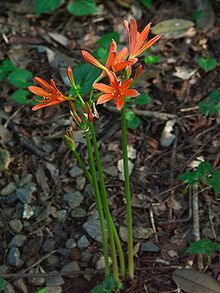Lycoris (plant)

Lycoris is a genus of 13–20 species of flowering plants in the family Amaryllidaceae, subfamily Amaryllidoideae.[3] They are native to eastern and southern Asia in China, Japan, southern Korea, northern Vietnam, northern Laos, northern Thailand, northern Burma, Nepal, northern Pakistan, Afghanistan, and eastern Iran. They were imported into North Carolina and now grow wild. In English they are also called hurricane lilies or cluster amaryllis. The genus shares the English name spider lily with two other related genera.[4][5][6]
They are bulb-producing perennial plants. The leaves are long and slender, 30–60 cm long and only 0.5–2 cm broad. The scape is erect, 30–70 cm tall, bearing a terminal umbel of four to eight flowers, which can be white, yellow, orange, or red. The flowers divide into two types, those with very long, filamentous stamens two or three times as long as the tepals (subgenus Lycoris; e.g. Lycoris radiata), and those with shorter stamens not much longer than the tepals (subgenus Symmanthus Traub & Moldenke; e.g. Lycoris sanguinea). The fruit is a three-valved capsule containing several black seeds. Many of the species are sterile, reproducing only vegetatively, and are probably of hybrid origin; several additional known hybrids occur.[4][5][7]
Since these scarlet flowers usually bloom near cemeteries around the autumnal equinox, they are described in Chinese and Japanese translations of the Lotus Sutra as ominous flowers that grow in Diyu (also known as Hell), or Huángquán (Simplified Chinese: 黄泉; Traditional Chinese: 黃泉), and guide the dead into the next reincarnation.
When the flowers of lycoris bloom, their leaves would have fallen; when their leaves grow, the flowers would have wilted. This habit gave rise to various legends. A famous one is the legend of two elves: Mañju (Simplified Chinese: 曼珠; Traditional Chinese: 曼珠), who guarded the flower, and Saka (Simplified Chinese: 沙华; Traditional Chinese: 沙華), who guarded the leaves. Out of curiosity, they defied their fate of guarding the herb alone, and managed to meet each other. At first sight, they fell in love with each other. God, exasperated by their waywardness, separated the miserable couple, and laid a curse on them as a punishment: the flowers of Mañju shall never meet the leaves of Saka again.
It was said that when the couple met after death in Diyu, they vowed to meet each other after reincarnation. However, neither of them could keep their word.
In commemoration of the couple, some call the herbs “Mañjusaka” (Simplified Chinese: 曼珠沙华; Traditional Chinese: 曼珠沙華), a mixture of “Mañju” and “Saka”, instead of their scientific name. The same name is used in Japanese, in which it is pronounced manju-syage.
Some other legends have it that when a person sees someone that they may never meet again, these flowers, also called red spider lilies, would bloom along the path. Perhaps because of these sorrowful legends, Japanese people often used these flowers in funerals. Popular name Higanbana (彼岸花, Higan bana) of Japanese for lycoris is literally higan (the other or that shore of sanzu river) flower means, decorate and enjoyable, flower of afterlife in gokuraku jyōdo (極楽浄土, gokuraku jyōdo).
